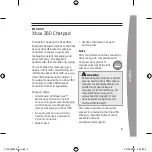
Instrument Gain and Offset Considerations
The user is provided with wide latitude in the selection of
pre-gain (PRE)
and
post-gain (POST)
. Practical
considerations should be recognized, since the linear operating range of both the input and output analog
circuitry is limited to ±10V peaks (7.07Vrms in the case of a sine wave) hence amplitudes greater than this
amount will result in saturation of the input or output. A large value of pre-gain may result in the saturation of
the analog input stages and no-amount of post-gain correction will restore linear operation. Likewise very large
values of post-gain may result in the saturation of the DSP output section. Very small values for post-gain may
create poor signal-to-noise ratios as the DSP output is severely attenuated.
Clip Indications
To assist the user in identifying potential saturation, (non-linear operating condition), two clip-indicators are
provided.
An analog clip indicator
(
←
←
CLIP)
indicates that the input voltage after the application of pre-gain
(PRE)
exceeds the maximum linear (±10 Volt) range of the instrument. This is an approximate detector. Depending
on the frequency and type of waveform applied to the input, non-linear operation may occur without an analog
clip indication.
A digital clip indicator
(CLIP
→
→
)
is activated when the peak-to-peak level of the output DSP waveform exceeds
the digital-to-analog converters maximum range after the application of post-gains
(POST)
.
Input Voltage Range
The ASC-50 has a maximum input operating voltage range of ±10Volts. Operation beyond this range will result
is the display of one or both
CLIP
indicators. Maximum safe input range (non-operating) is noted in the
specification.
DC Offset Capability
The DC offset capability allows the ASC-50 to accept input waveforms with DC levels that would otherwise
cause the instrument to saturate, especially at high gain levels. The offset value displayed represents the
approximate voltage that the input stage is offset from zero (0) Volts. Some external means of measuring the
effect of a DC offset change is needed, such as a voltmeter or oscilloscope. The value presented is
approximate, effects of drift must be recognized. Amplified dc offset can cause internal saturation and activation
of the clip indicator.
DSP Bypass Control
The overall frequency response of the ASC-50 is the cascade of the anti-alias and reconstruction filters as well
as the DSP filter chosen. DSP Bypass (
BYP
) allows the operator to remove the DSP filter from the cascade
while retaining frequency sampling along with anti-alias and reconstruction filtering.
Several uses for bypass are indicated. In order to judge the effect of the channel bandwidth, the DSP filter is
temporarily removed, allowing a measurement to be made. Gain and phase responses can be obtained for
DSP filters alone or by “normalizing” (using a relative 0dB gain and 0
°
phase) for sampling anti-alias and
reconstruction filters. It must be remembered
that Bypass does not bypass the entire ASC-50
but merely
the internal DSP filter.
25 Locust St, Haverhill, Massachusetts 01830 • Tel: 800/252-7074, 978/374-0761 • FAX: 978/521-1839
e-mail: [email protected] • Web Address: http://www.freqdev.com
ASC-50
Operation
Manual
9












































